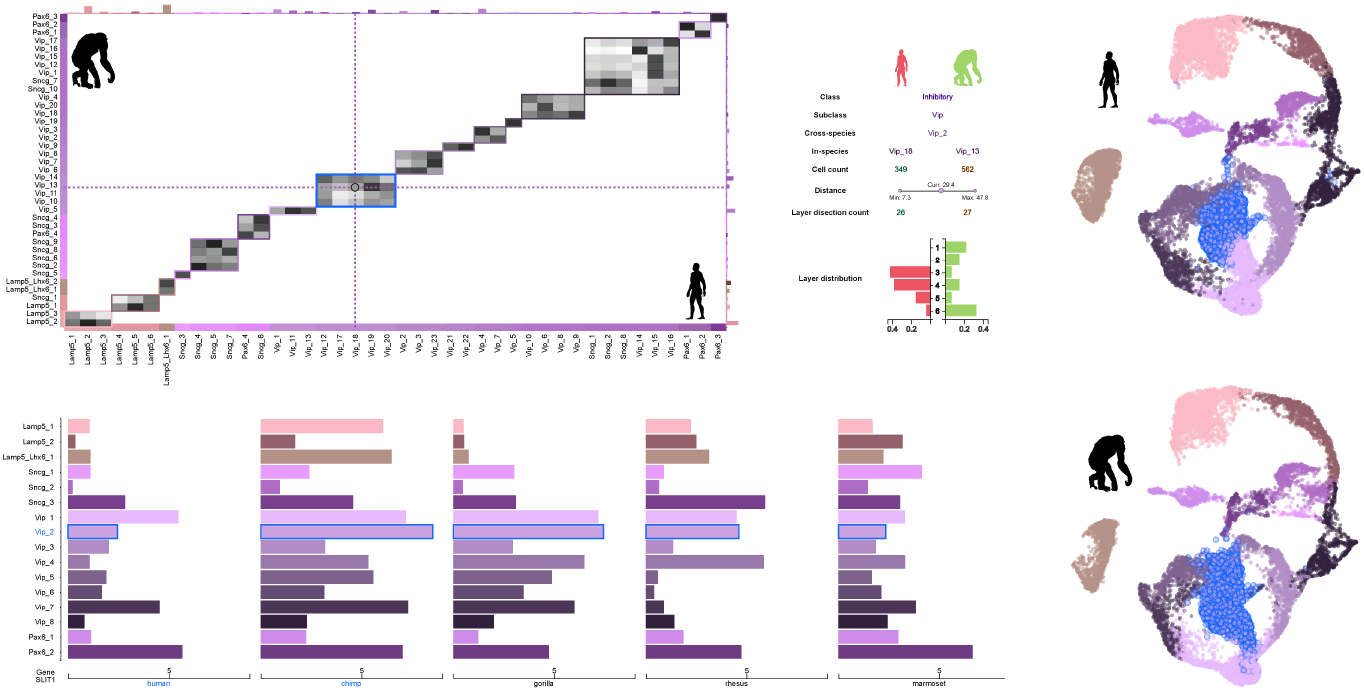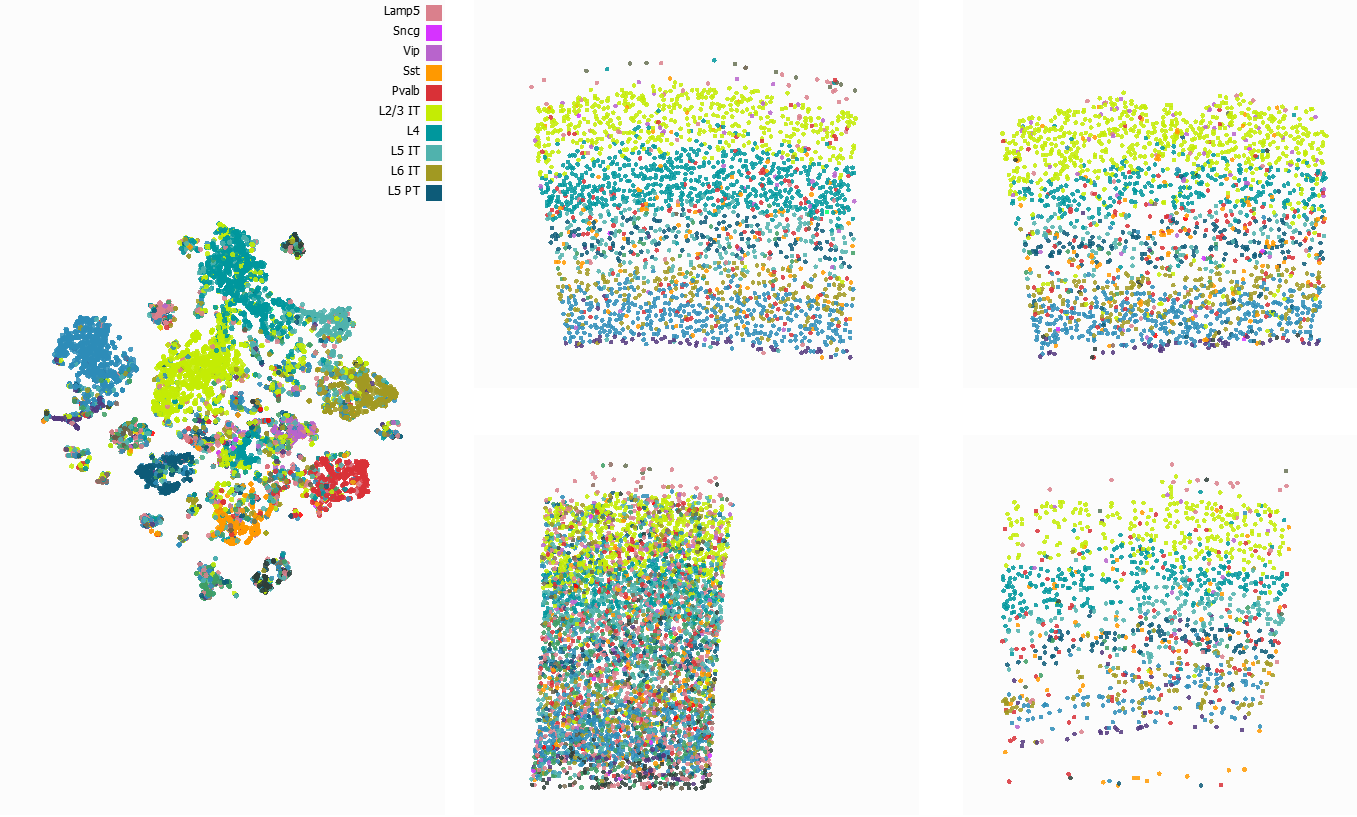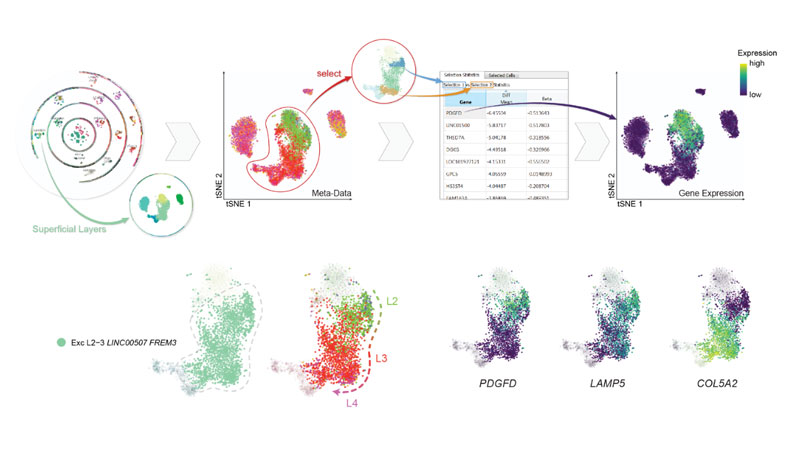Cytosplore Viewer
Cytosplore Viewer is an interactive visual analysis system for the exploration of single cell data
published in the Allen Cell Types Database
and for a number of the single cell data resources of the Brain
Initiative Cell Census Network (BICCN), and the Brain Initiative Cell Atlas Network (BICAN).
Currently supported datasets include the October 2019 data releases in the Allen Cell Types Database of
the Allen Institute for Brain Science: nuclear sequencing data of several areas of the human cortex, and
single cell sequencing data of the mouse cortex and hippocampus.
Also supported are special modes for:
- cross-species comparison of cell types in the motor cortex between human, marmoset and mouse of BICCN (see Comparative cellular analysis of motor cortex in human, marmoset, and mouse below).
- comparing different spatial transcriptomics techniques of the SpaceTx Consortium (see SpaceTx: A Roadmap for Benchmarking Spatial Transcriptomics Exploration of the Brain below).
Cytosplore Viewer allows an interactive exploration of hierarchies of cell types. One can visualize transcriptome-wide gene expression in combination with metadata of individual cells, perform differential analyses and statistics between manual selections of cells, or between pre-defined clusters throughout the cellular hierarchy and more. Cytosplore Viewer is based on Cytosplore and provides many of the analysis tools presented in the previous Cytosplore publications.
To gain insights into the cell type and gene expression differences and similarities between humans and 4 different species of primates there is now a special version: Cytosplore Simian Viewer which was developed in for the Comparative transcriptomics reveals human-specific cortical features journal article published in Science, Volume 382, Issue 6667.
Team
LUMC
Development
LUMC
Development
LUMC
Development
LUMC
Development
TU Delft
PI VAnPIRe
TU Delft / LUMC
Project Lead Cytosplore
LUMC
PI LKEB
Cytosplore Viewer is being developed by a team consisting of members from the Leiden Computational Biology Center, the Division of Image Processing at the Leiden University Medical Center, and the Computer Graphics and Visualization Group at the TU Delft in a research project, carried out in close collaboration with Trygve Bakken, Jeremy Miller, Brian Long, Nik L. Jorstad, Rebecca Hodge, Bosiljka Tasic, Zizhen Yao, Lucas T. Graybuck, Hongkui Zeng, Mike Hawrylycz , and Ed Lein from the Allen Institute for Brain Science.
This work was partially supported by an NWO Gravitation grant:BRAINSCAPES: A Roadmap from Neurogenetics to Neurobiology (NWO: 024.004.012) and NWO AES grants 3DOMICS (NWO: 17126), VANPIRE (NWO: 12720) and Genes in Space (NWO: 12721).
Publications

Comparative transcriptomics reveals human-specific cortical features , Science, 2023
Abstract: The cognitive abilities of humans are distinctive among primates, but their molecular and cellular substrates are poorly understood. We used comparative single-nucleus transcriptomics to analyze samples of the middle temporal gyrus (MTG) from adult humans, chimpanzees, gorillas, rhesus macaques, and common marmosets to understand human-specific features of the neocortex. Human, chimpanzee, and gorilla MTG showed highly similar cell-type composition and laminar organization as well as a large shift in proportions of deep-layer intratelencephalic-projecting neurons compared with macaque and marmoset MTG. Microglia, astrocytes, and oligodendrocytes had more-divergent expression across species compared with neurons or oligodendrocyte precursor cells, and neuronal expression diverged more rapidly on the human lineage. Only a few hundred genes showed human-specific patterning, suggesting that relatively few cellular and molecular changes distinctively define adult human cortical structure. ...
The Cytosplore Simian Viewer was developed as part of the article above. The viewer itself is described in more detail in Cytosplore Simian Viewer: Visual Exploration for Multi-Species Single-Cell RNA Sequencing Data , VCBM 2023: Eurographics Workshop on Visual Computing for Biology and Medicine , 2023

SpaceTx: A Roadmap for Benchmarking Spatial Transcriptomics Exploration of the Brain , arXiv - Quantitative Biology, 2023
Abstract: Mapping spatial distributions of transcriptomic cell types is essential to understanding the brain, with its exceptional cellular heterogeneity and the functional significance of its spatial organization. Spatial transcriptomics techniques are hoped to accomplish these measurements, but each method uses different experimental and computational protocols, with different trade-offs and optimizations. In 2017, the SpaceTx Consortium was formed to compare these methods and determine their suitability for large-scale spatial transcriptomic atlases. SpaceTx work included progress in tissue processing, taxonomy development, gene selection, image processing and data standardization, cell segmentation, cell type assignments, and visualization. Although the landscape of experimental methods has changed dramatically since the beginning of SpaceTx, the need for quantitative and detailed benchmarking of spatial transcriptomics methods in the brain is still unmet. Here, we summarize the work of SpaceTx and highlight outstanding challenges as spatial transcriptomics grows into a mature field. We also discuss how our progress provides a roadmap for benchmarking spatial transcriptomics methods in the future. Data and analyses from this consortium, along with code and methods are publicly available at this https URL. ...

Comparative cellular analysis of motor cortex in human, marmoset, and mouse , Nature, 2021.
Abstract: The primary motor cortex (M1) is essential for voluntary fine motor control and is functionally conserved across mammals. Using high-throughput transcriptomic and epigenomic profiling of over 450,000 single nuclei in human, marmoset monkey, and mouse, we demonstrate a broadly conserved cellular makeup of this region, whose similarity mirrors evolutionary distance and is consistent between the transcriptome and epigenome. The core conserved molecular identity of neuronal and non-neuronal types allowed the generation of a cross species consensus cell type classification and inference of conserved cell type properties across species. Despite overall conservation, many species specializations were apparent, including differences in cell type proportions, gene expression, DNA methylation, and chromatin state. Few cell type marker genes were conserved across species, providing a short list of candidate genes and regulatory mechanisms responsible for conserved features of homologous cell types, such as the GABAergic chandelier cells. This consensus transcriptomic classification allowed the Patch-seq identification of layer 5 (L5) corticospinal Betz cells in non human primate and human and characterization of their highly specialized physiology and anatomy. These findings highlight the robust molecular underpinnings of cell type diversity in M1 across mammals and point to the genes and regulatory pathways responsible for the functional identity of cell types and their species specific adaptations. ...

Conserved Cell Types With Divergent Features in Human Versus Mouse Cortex. , Nature, 2019.
Abstract: Elucidating the cellular architecture of the human cerebral cortex is central to understanding our cognitive abilities and susceptibility to disease. Here we used single-nucleus RNA-sequencing analysis to perform a comprehensive study of cell types in the middle temporal gyrus of human cortex. We identified a highly diverse set of excitatory and inhibitory neuron types that are mostly sparse, with excitatory types being less layer-restricted than expected. Comparison to similar mouse cortex single-cell RNA-sequencing datasets revealed a surprisingly well-conserved cellular architecture that enables matching of homologous types and predictions of properties of human cell types. Despite this general conservation, we also found extensive differences between homologous human and mouse cell types, including marked alterations in proportions, laminar distributions, gene expression and morphology. These species-specific features emphasize the importance of directly studying human brain ...

Shared and Distinct Transcriptomic Cell Types Across Neocortical Areas. , Nature, 2018.
Abstract: The neocortex contains a multitude of cell types that are segregated into layers and functionally distinct areas. To investigate the diversity of cell types across the mouse neocortex, here we analysed 23,822 cells from two areas at distant poles of the mouse neocortex: the primary visual cortex and the anterior lateral motor cortex. We define 133 transcriptomic cell types by deep, single-cell RNA sequencing ...
Get Cytosplore Viewer
Disclaimer: Cytosplore Viewer is a research project between TU Delft and Leiden University Medical Center. We do our best to provide support but cannot guarantee it. If you have any suggestions, problems, want to share your success stories or papers published using Cytosplore Viewer, we would love to get feedback! Please do not hesitate to get in touch.
Cytosplore Viewer is free to use. Users should adhere to the Allen Institutes data terms of use and citation policy. If you use Cytosplore Viewer within the scope of a scientific article you must cite the original publications.
For other operating systems or older versions please see the release archive.




